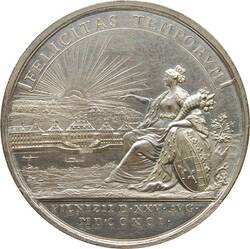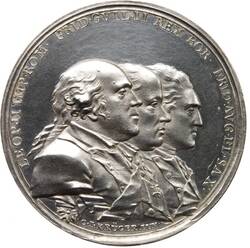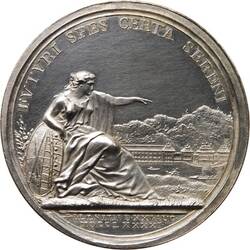Further Media
Frederick Augustus III of Saxony commissioned a variety of art works to both commemorate and glorify the Declaration of Pillnitz, the culmination of meetings held there between 25 and 27 August 1791. Although the Saxon Elector was merely the host of the meeting (rather than a negotiating party in it), the three contiguous profile portraits of Emperor Leopold II (centre), the Prussian King Frederick William II (left) and Frederick August III (right) on the obverse (front) of these two medals create the impression of a more active role. The corresponding painting by Johann Heinrich Schmidt also depicts the Saxon Elector as a mediator between his high-ranking guests.
The reverse of the medals underlines the importance of the venue: the female figure, identifiable as Saxonia thanks to her escutcheon, points to Pillnitz Castle behind her. In the case of the medal signed by Karl Wilhelm Hoeckner, she is even represented as a queen, adorned with a crown, a cornucopia and an ermine cloak, while the sun rises behind the castle. The inscriptions on both medals bear witness to the hopes that the Electorate placed in the rapprochement between the two arch-rivals Prussia and Austria: secure prospects for a serene future (Futuri spes certa sereni) and for happy times (Felicitas Temporum) respectively.
It is worth adding that these medals are the earliest surviving depictions of the wings that were added to the Bergpalais and the Wasserpalais from the late 1780s onwards in preparation for the meeting of the monarchs. You are now standing in one of these extensions.
Text: Alexander Röstel


